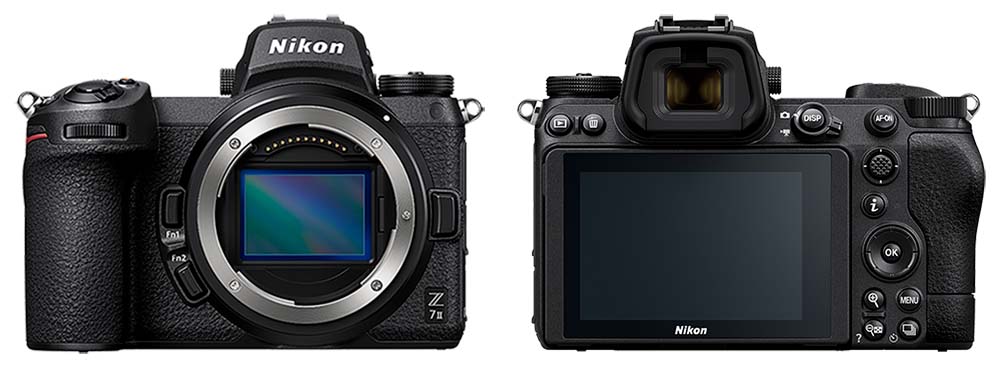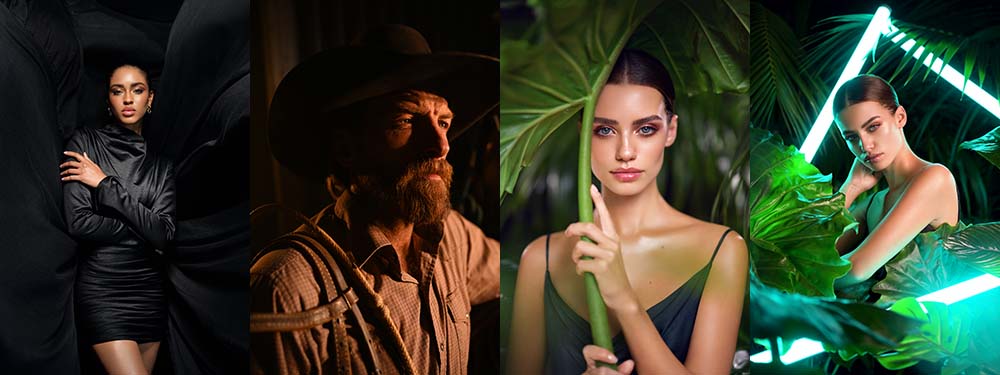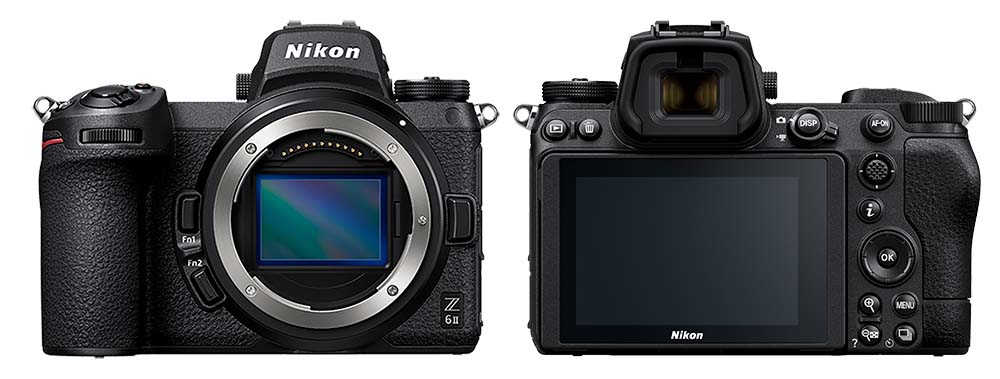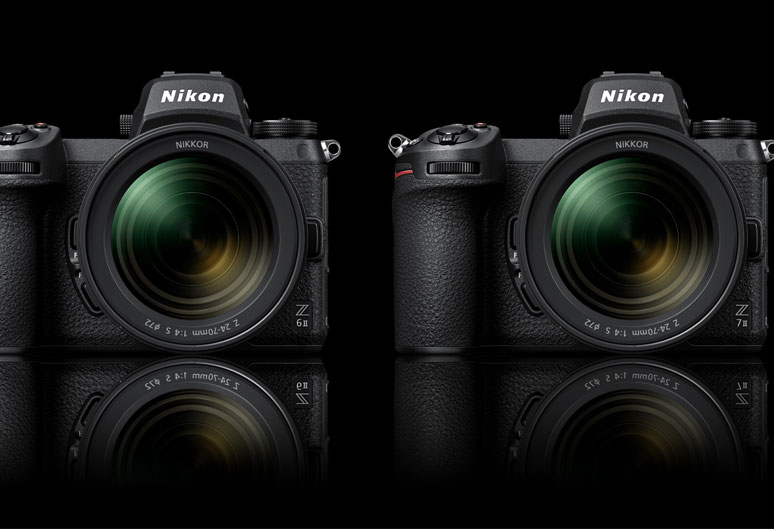The Z6 II and Z7 II digital camera bodies are the next generation of flagship full-frame mirrorless cameras from Nikon. Both cameras deliver high speed, high resolution, superb image quality, and high build standards for professional use in harsh environments.
But which model is going to best suit your needs?
Let’s compare them after a quick look at the Z System itself.
The Nikon Z System
The Z system from Nikon is built around the Z mount, the new larger and shallower lens mount for Nikon mirrorless digital cameras. The Z mount supports a growing range of Nikkor ‘Z series’ Nikkor lenses. These cameras can be adapted to work with Nikon AF-S lenses with the Nikon FTZ mount adaptor.
There are, however, benefits to using the native Z lenses which we explore in our complete guide to Nikon Z lenses.
Modern mirrorless cameras do not feature an optical viewfinder or separate AF sensor. Both of these require a bulky mirror box found in all DSLR cameras. The result is more responsive and less cumbersome camera with a faster and more accurate AF system.
Next Generation Full-Frame Mirrorless Cameras
Nikon has updated its original mirrorless bodies to the new Z6 II and Z7 II models. Both updates feature dual memory card slots which carry UHS-II SD cards and either XQD or CF Express cards.
The image flow, from pressing the shutter to safely stored on the memory card, has been improved with Dual EXPEED 6 processing engines. An improvement to the image buffers making them deeper and faster for un-interrupted continuous burst shooting.

Nikon Z7 II
The Z7 II builds on the success of the award-winning Nikon Z7. The updated Nikon Z7 II features a 45.7-megapixel sensor and has an improved dynamic range at all ISO levels. The processing power from dual EXPEED 6 processors along with an improved buffer enable continuous shooting at up to 10 frames per second. The Nikon Z7 II can shoot a continuous burst of 200 full resolution jpeg images, or 77 12-bit uncompressed RAW files before reaching the buffer limit.
- High resolution – 45.7 megapixels plus 4K/60p video
- Reliable fast media – shoot to both UHS-II SD and XQD / CF-Express cards
- Fast and sharp AF – selected focus point saved when waking from standby
- Continuous shooting – high resolution RAW files at 10 fps
- Tough – fully sealed body for harsh shooting environments

[gdlr_divider type=”solid” size=”50%” ]

Nikon Z6 II
The Z6 II is the evolution of the original Z6. The camera is robust and easy to use. The Nikon Z6 II combines powerful performance for both photography and video. With the ability to record professional 4K or Full HD video in both full-frame FX and cropped DX movie formats, the Z6 II impresses.
The 24.5-megapixel sensor is supported by AF improvements to Eye Detection and Animal Detection for reliable subject tracking. The improved AF capabilities benefit video and filmmakers as well delivering smooth focus tracking.
- Low light performance – focus at -6 EV
- Faster – record up to 124 RAW files at 14 frames per second
- Power boost – twin EXPEED 6 processors for faster everything
- For photography and video – combine 4K video footage with 24.5 megapixel stills
- Eye AF and Animal-detection AF – available to enhance stills and video
Which is the best model for me?
Both models gain from equivalent boosts in processing speed thanks to the new dual EXPEED 6 processors, as well as improvements to image buffering.
Fair enough, so what’s the biggest difference?
The simplest answer is sensor resolution.
The Z6 II sensor is 24.5-megapixels, which should be more than enough resolution for most. If you want to level up, consider that the Z7 II has nearly double that at 45.7-megapixels, which is a sizeable jump.
If lower memory usage is important, you may decide the Z6 II is a better fit for you. The reduced megapixels will help maintain all-important card space. The Z7 II’s high-res usage comes at a memory card space premium.
The Z6 II makes a standout choice for video and as a brilliant general-purpose camera for stills. the Z7 II is a specialised model, likely better suited to those that really require high-resolution imagery in their field of choice.
A final consideration is whether or not you need professional-grade durability for tough conditions. If so you would be wise to invest in the Z7 II for that full seal. Is that worth the difference in price though?
The Z6 II itself is a robust camera, so unless you are really hard on your equipment or regularly use your camera in harsh environments, it should more than suffice. It also has slightly better autofocus and continuous shooting specifications that makes it a very enticing prospect indeed.
Upgrade to the Z7 II if you need those extra megapixels at your fingertips.
| Sensor Comparison | Nikon Z7 II | Nikon Z6 II |
|---|---|---|
| Sensor Size | Full Frame | Full Frame |
| BSI-CMOS Sensor Resolution | 46 MP | 25 MP |
| Anti Aliasing AA filter | No | Yes |
| Continuous shooting rate | 10 fps | 14 fps |
| ISO Range | 64 – 25600 | 100 – 51200 |
| Expanded ISO Range | 32 – 102400 | 50 – 204800 |
| Image Stabilisation | Yes – IBIS | Yes – IBIS |
| Number of autofocus AF Points | 493 | 273 |
| Video Resolution | 4k (UHD) 3840 x 2160 | 4k (UHD) 3840 x 2160 |
| Connectivity | Nikon Z7 II | Nikon Z6 II |
| Memory Cards | UHS II SD and CF Express / XQD | UHS II SD and CF Express / XQD |
| Built in WiFi | Yes | Yes |
| Body & Dimensions | Nikon Z7 II | Nikon Z6 II |
| Weight | 705g | 705g |
| Dimensions W x H x D mm | 134 x 101 x 70 | 134 x 101 x 70 |
| Battery Life | 420 Shots | 410 Shots |
| Weather Sealing | Yes | Yes |
| Viewfinder | 3690k dot EVF | 3690k dot EVF |
| LCD Monitor | 3.2inch tilting screen | 3.2inch tilting screen |

Contact our sales team on 020 7582 3294 or email us at sales@fixationuk.com


Does the Z6 II now work with the Ninja V without needing a “movie” upgrade? as the Z6 needed?
Hi Paul, yes compatible from the start external recorders. External recorders are required for the Z6 II recording in HLG formats.
One video setting that is waiting on a firmware update is the 4k/60p frame rate, expected February 2021. Out of the box the Z6 II will record up to 4k/30p video or Full HD/120p.